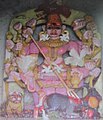Shree Dev Vyadeshwar
| Shri Dev Vyadeshwar | |
|---|---|
 The sanctum with the central icon of the linga of Shiva | |
| Religion | |
| Affiliation | Hinduism |
| District | Ratnagiri |
| Location | |
| State | Maharashtra |
| Country | India |
| Geographic coordinates | 17°28′N 73°12′E / 17.47°N 73.2°E |
Shri Dev Vyadeshwar is a Hindu temple dedicated to the God Shiva. It is located in Guhagar, Ratnagiri District of the Indian state of Maharashtra State.[1][2] It is considered the Kuladevata (Clan God) of many Chitpavan families from the Konkan region.
Legend
According to Hindu mythology, sage Parashurama created the land of Konkan by shooting his arrow into the sea and commanding the Sea God to retract the waters to the point where his arrow landed. This new land came to be known as Sapta-Konkana, meaning "piece of earth", "corner of earth", or "piece of a corner", derived from Sanskrit words: koṇa (कोण, corner) + kaṇa (कण, piece).[3][4][5]
He asked various deities to settle in the newly created land and protect the resident clans. Parashurama was a devotee of the god Shiva, requested that the God appear to him daily, so Shiva appeared in 60 places where temples were built. The sage Vyad then installed the lingam of Shiva at this temple in Guhagar. The Shiva icon and temple was thus called Vyadeshwar (the Lord of Vyad).
Vyadeshwar was lost to time and rediscovered in the era of King Sakuran, when the current temple structure was constructed.[6]
Style
The architectural style is called 'Panchayatan'. A Panchayatan temple contains four subordinate shrines in four corners and the main shrine in the center of the podium, which forms the base.[7] Here, Shiva is Vyadeshwar the central shrine, with Surya, Ganesha, Ambika (Shiva's consort) and Vishnu with his wife Lakshmi as the South-East, South-West, North-West and North-East subordinate shrines respectively. Nandi (the vahana of Shiva) sits in front of the main shrine.
The temple has three entrances to the east, west and south. Garuda (the vahana of Vishnu) and the god Hanuman are installed on either sides of the East entrance, inside the temple.
Updates
This 'Panchayatan' temple is ancient, as are its deities. Due to aging, the three shrines were found eroded. In May 2015, the shrines of Shri Parvati (Ambikamata), Shri Garud and Shri Hanuman were ceremonially replaced by new shrines. All the required reinstatement rituals were systematically performed. The old entrance facing due East was small in size and inconvenient. That entrance (Mahadwar in local Marathi language) was replaced with a completely renovated form of the temple.[8]
Incarnations of Shri Vyadeshwar
Three small pieces were chipped out from the main or core part of the Pindi. One piece was located at Borya Adoor; the second piece went to Asgoli and the third piece to Anjanwel.[2] At these locations, new Shiva temples were erected. These temples are known as Talkeshwar, Balkeshwar (Valukeshwar) and Udaleshwar (Uddalakeshwar),[9] respectively. These three Shiva Pindis are considered to be incarnations of Shri Vyadeshwar. Devotees of Shri Vyadeshwar are instructed to visit these three temples.
Nearby holy sites
Other holy places reflect the presence of different deities : Shree Chandikai Kalkai Temple (Waghivare), Garamath, Velneshwar, Tarakeshwar, Taldeo, Kartikeya, Someshwar, Sapteshwar, Karneshwar, Karhateshwar,[10] Kutakeshwar, Hrudakeshwar, Saptakotishwar, Dalbhyeshwar, Harihareshwar, Bhairav, Rameshwar, Chyavaneshwar, Ufrata Ganesh, Karanjeshwari Pethmap Chiplun and Durga Devi temple, Guhagar.
Shri Vyadeshwar Mantra and Aarti

In Sanskrit, the holy prayer for chanting is called a Mantra while a poem that describes specialties of the deity is called an Aarti. Shri Vyadeshwar Mantra is given in adjacent picture while snap of Shri Vyadeshwar Aarti is given in Gallery.
Gallery
Following are the relevant photographs:
-
Official Shri Vyadeshwar Aarti
-
Shri Talkeshwar
-
Shri Balkeshwar
-
Shri Uddalakeshwar
-
Shri Talkeshwar Mandir
-
Shri valukeshwar mandir
-
Shri Uddalakeshwar Mandir
-
Shri Ganesh from shri vyadeshwar Panchayatan
-
The Sun from shri vyadeshwar Panchayatan
-
Shri Vishnu from shri vyadeshwar Panchayatan
-
Shri Ambika Mata from shri vyadeshwar Panchayatan
-
Shri Garud
-
Shri Maruti
-
New Shrine of Shri Ambikamata
-
New Shrine of Shri Garud
-
New Shrine of Shri Maruti
-
Shri Nandi
-
Shri Vyadeshwar dahibhat limpan
-
Decorated Pindi with dahibhat limpan
See also
References
- ^ "Vyadeshwar Temple, Guhagar". www.nativeplanet.com.
- ^ a b "Gazetteer of the Bombay Presidency - Ratnagiri and Savantvadi". ratnagiri.nic.in.
- ^ Shastri Gaytonde, Gajanan (ed.). Shree Scanda Puran (Sayadri Khandha) (in Marathi). Mumbai: Shree Katyani Publication.
- ^ Satoskar, B. D. Gomantak Prakruti ani Sanskruti. Part 1 (in Marathi). Shubhada Publication. p. 206.
- ^ Shrikant Gowande (2007),"Guhagarche Swayambhoo Devasthan Shri Kshetra Vyadeshwar", Anmol Publication, Pune 411002.
- ^ http://www.konkanyatra.com/chiplun/g8.html
- ^ "Welcome the-world-heritage-sites.com - BlueHost.com". www.the-world-heritage-sites.com.
- ^ http://vyadeshwar.webs.com/
- ^ "Uddalakeshwar Shiv Temple - Wikimapia". wikimapia.org.
- ^ https://www.tripadvisor.in/Attraction_Review-g297648-d3410784-Reviews-Karhateshwar_Temple-Maharashtra.html
External links
- Velavan Beach House -Coastal Homestay at Guhagar





















